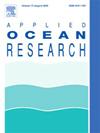DCNet: DVL校准的数据驱动框架
IF 4.3
2区 工程技术
Q1 ENGINEERING, OCEAN
引用次数: 0
摘要
自主水下航行器(auv)是一种用于各种应用的水下机器人平台。AUV的导航解决方案在很大程度上依赖于惯性传感器和多普勒速度日志(DVL)的融合,后者提供准确的速度更新。为了确保精确导航,在任务开始估计其误差项之前进行DVL校准。在标定过程中,AUV遵循复杂的轨迹,并采用非线性估计滤波器估计误差项。在本文中,我们介绍了DCNet,一个数据驱动的框架,它以一种创新的方式利用了二维卷积核。利用DCNet和我们提出的DVL误差模型,我们提供了快速校准程序。这可以应用于几乎匀速的轨迹。为了训练和测试我们提出的方法,使用了276分钟长的真实DVL记录测量数据集。我们证明,与低性能DVL的基线方法相比,该方法的准确率平均提高了70%,校准时间平均提高了80%。由于这些改进,采用低成本DVL的AUV可以实现更高的精度,更短的校准时间,并应用简单的几乎恒定速度的校准轨迹。我们的研究结果也为利用低成本、高精度dvl的海洋机器人开辟了新的应用。本文章由计算机程序翻译,如有差异,请以英文原文为准。
DCNet: A data-driven framework for DVL calibration
Autonomous underwater vehicles (AUVs) are underwater robotic platforms used in a variety of applications. An AUV’s navigation solution relies heavily on the fusion of inertial sensors and Doppler velocity logs (DVL), where the latter delivers accurate velocity updates. To ensure accurate navigation, a DVL calibration is undertaken before the mission begins to estimate its error terms. During calibration, the AUV follows a complex trajectory and employs nonlinear estimation filters to estimate error terms. In this paper, we introduce DCNet, a data-driven framework that utilizes a two-dimensional convolution kernel in an innovative way. Using DCNet and our proposed DVL error model, we offer a rapid calibration procedure. This can be applied to a trajectory with a nearly constant velocity. To train and test our proposed approach a dataset of 276 min long with real DVL recorded measurements was used. We demonstrated an average improvement of 70% in accuracy and 80% improvement in calibration time, compared to the baseline approach, with a low-performance DVL. As a result of those improvements, an AUV employing a low-cost DVL, can achieve higher accuracy, shorter calibration time, and apply a simple nearly constant velocity calibration trajectory. Our results also open up new applications for marine robotics utilizing low-cost, high-accurate DVLs.
求助全文
通过发布文献求助,成功后即可免费获取论文全文。
去求助
来源期刊

Applied Ocean Research
地学-工程:大洋
CiteScore
8.70
自引率
7.00%
发文量
316
审稿时长
59 days
期刊介绍:
The aim of Applied Ocean Research is to encourage the submission of papers that advance the state of knowledge in a range of topics relevant to ocean engineering.
 求助内容:
求助内容: 应助结果提醒方式:
应助结果提醒方式:


